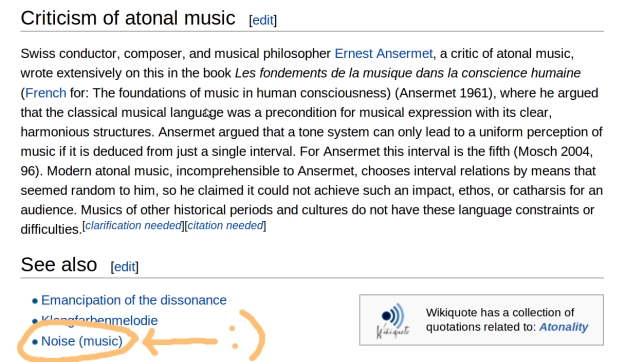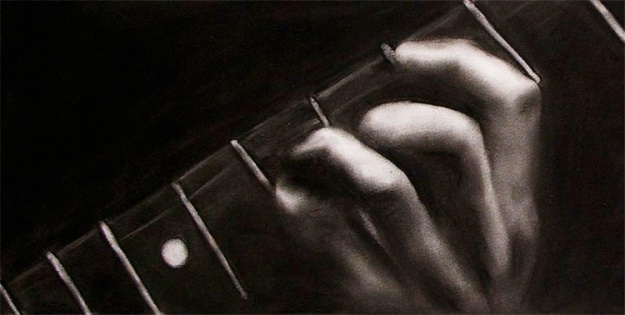
A composition in A
minor
What do we perceive as happy or sad in music? Is it the notes, chords, pattern of notes, pattern of chords, tempo, rhythm, arrangement or all of it taken together?
As a keyboardist, the first answer that comes to my mind is musical mode or scale. Everyone thinks that Major mode=Happy and Minor mode=Sad. No tempo, rhythm or arrangement has such a consistent interpretation.
It would be great if we could equate other Western modes or scales to an emotion/mood too. However, even though the happiness of the Major mode and the tragedy of the Minor mode is almost universally agreed upon, I don’t think the same would work for all the remaining modes. For instance, I know many happy and sad songs in the Blues scale – a scale which allows for a lot of diversity.
In spite of this confusion, people have attempted such a classification. Here is an impressive blog post with a nearly exhaustive list of scales/modes and their emotional content. I must say that such a list is extremely useful for an ameteur composer.
While such classifications are good, they leave a more basic and interesting question unanswered : What aspects of a mode gives rise to its characteristic mood? What is it that your brain interprets as happy or sad?
I will try to answer this question from a musical point of view.
The most popular explanation for the influence of modes on moods is : It’s the collection of notes that color a composition. The collection of notes in a mode, by virtue of their musical intervals, are of course happy or sad in their own right. If the ingredients are happy, as in the case of the Major mode, then any structure or pattern made out of those happy elements will turn out to be happy.
The wonderful simplicity of this logic fooled me (and many of my friends) for a long time. Anyone would agree that Collection of Notes=Mood is quite the elegant solution. In fact, I believed and advocated this idea until very recently.
Unfortunately this pretty piece of logic is wrong. I am sorry to say that the truth (which they say is stranger than fiction) seems to be the opposite.
Notes in a scale do not have any emotional content.
Let me draw your attention to four facts which conclusively prove this.
1. Seven distinct Western modes/scales can be played on the same
set of notes
2. The definition of scale is widely misunderstood. Scales work
because of cadences, chord domination and few other rules and not
because they have a cerain set of notes in them
3. There are examples of distinct Eastern modes which have the same
set of notes and the same tonic!
4. Atonal music, which lacks a tone center, sounds like nothing you
have heard before!
Some of these facts are quite astonishing. It will do us good to discuss in detail and find out what these four facts really mean. I hope that at the end of it, you will appreciate that notes are quite irrelevant to the emotional content of a musical piece and find out what it is that (what aspect of scales) invokes emotion in music.
Seven distinct Western modes can be played on the same set of notes:
There are seven commonly known modes in Western music.
Ionian (Major)
Dorian
Phrygian
Lydian
Mixolydian
Aeolian (Minor)
Locrian
Most popular compositions are based on the Aeolian and the Ionian modes because they support harmony best. The rest of the Modes are not so commonly used. It is well known that each of these modes have their own individual flavor and basic mood. The Ionian for example is usually happy and the Aeolian sad.
The most well known scale in music (partly because of how music is taught) is the C Ionian or Major mode which has the notes {CDEFGAB}.

C Ionian mode
The surprising (and much less known because it requires knowledge of Modes) fact is that the ingredients of D Dorian is also {CDEFGAB}. E Phrygian consists of (yes! you guessed it!) {CDEFGAB} too! And this pattern goes on till B Locrian. Of course, each mode has its own characteristic mood. Same notes make up different modes and give rise to different moods. Turning the argument around : all seven moods corresponding to the seven modes can be played on the same set of notes {CDEFGAB}. A pianist would recognize that these are the white keys of the piano.
You might ask: What about C Dorian (C Dorian for example has the notes {CDEbFBABb}) or C Phrygian? Shouldn’t we consider them? What moods do they convey?
The answer is no, you don’t need to consider them separately. Moodwise, C Dorian is the same as D dorian. As long as you are using the same mode, the absolute frequency does not matter. It can be freely transposed. This freedom is extensively used in Indian classical music where modal compositions are not set in any root such as C or D or E. The vocalist sounds the root note as per his convenience and the stringed accompaniemnts (usually only one or two instruments) set their frequencies relatively starting from the root.
2. What makes modes (scales) work :
If all the modes can be played by using the same notes, then how does a composer convey what mode (and hence what root or tonal center) he is using? Not by the notes that he plays as we discovered in the previous section. It turns out that in the Western system this is done via two well known rules :
Sections end with a cadence : A cadence is a series of two or more chords which ends at the root chord of the scale. This is most commonly implemented via a V-I chord progression. IV-I or VII-I are some of the alternate cadences that are used in practice. Thus if you are primarily using notes of the scale {CDEFGAB} and your cadence consists of a G Major chord to a C Major chord, then you can be said to have established the C Ionian or Major mode which sounds happy. If instead your cadence consists of a E minor going to a A minor chord, then you have effectively established the A Aeolian or Minor mode which sounds sad. For more on cadences, check out this YouTube video.
Which chords dominate? : In each of the seven modes, different chords (I am not talking about chord degrees here but the absolute chord name) will dominate. For example, C Major, G Major and F Major will dominate a composition in C major. Eminor, D minor and A minor will dominate in the A minor scale. These three sets of chords are the first, fourth and fifth relative to the root or tonic C and A of the scales C Major and A minor respectively. Is it always the first, fourth and fifth that dominate? No, because in the B Locrian mode, for instance, the first degree is B diminished, which is a highly unstable chord. Only a foolish classical composer will let a diminished chord dominate his composition. In fact it turns out that modal composition in Locrian is almost impossible for this reason.
Cadence and chord domination are techniques employed by the composer to give the audience a feeling of being in scale. Compositions derive their scales not from the notes of the composition, but on these techniques. Hence it is not stupid to expect that the mood of the composition is colored not by the notes themselves in their own right, but on how those techniques embed notes within the composition..
Are these rules complete? I don’t think so. Many known classical compositions take quite a long time to come to the cadence or explicitly show chord domination, probably with an intent to fool the listener. Listeners with an acute musical ear sadly cannot be fooled this way. It turns out that they can easily tell you the scale before the cadence finally arrives unless there is a significant mood change after the prediction. This raises the questions: What unwritten rules are the listeners using? What unwritten rules did the composers use subconsciously which gave them away? These are unanswered questions as far as Western music is concerned. The same is not true for the Indian Classical system, where the rules are stricter. It will do us good if we digress for a moment and examine the rules that are laid out for modal compositions in the Oriental system of classical music.
Modes or Ragas in Indian Classical music:
Indian classical music performance
Indian classical music (here is a typical performance on the flute) is a melody driven way of music where harmony takes a dusty back seat. In fact the only harmony that you will find in a Oriental classical music performance is an ever present and unchanging drone on a stringed instrument called the Tanpura which sounds a few major notes (usually the tonic and the fifth) of the scale. The maestro performs over this drone with the accompaniment of a percussion instrument.
Lack of harmony in Indian classical music
The lack of harmony in Indian classical music is not due to the limitation of knowledge. It is because the emphasis on melody has been taken Indian music in such a direction that harmony is not even possible in most cases. This can be understood by a comparison with the Locrian mode in the western system which does not support harmony because the tonic chord is a diminished and hence unstable. Loosely speaking, Indians have 200 modes while there are only 7 commonly known (but not all are commonly used) modes in Western music. No wonder Indians cannot harmonise their melodic music!
Fusion music
In modern days, many groups have tried to fuse Western and Indian music (this is a great example from Coke Studio) to make new music. The funny thing is most of these compositions are still based on the Aeolian or Ionian modes. It is fusion music because they follow the other Oriental modal rules (which we will come to in a moment) in their composition. But theoretically, this is not new music, because the mode is still Western or an Indian equivalent of a Western mode.
Rules in Indian modal compositions
The closest equivalent of a mode in the Indian classical system is called Ragas on which compositions are based. Each Raga, like a mode, consists of seven notes (swaras) derived from a tonic or root. So far this sounds exactly similar to the Western system. However the sequence of notes does not make up the mode by themselves. There are additional compositional rules and recommendations which are absent in the Western system. These rules are:
Ascent in the Raga (Arohona): While ascending upward the notes are to be used in a specific sequence ONLY. These rules sometimes call for retrograde motion, jumps or complete omission of notes while ascending.
Descent in the Raga (Avorohana): While descending downward the notes are to be used in a specific sequence (which may not be derived from the rules for ascending). These rules sometimes call for retrograde motion, jumps or complete omission of notes while descending.
An example will make this clearer. For example the Raga Jaunpuri with the tonic at C has the notes {CDEbFGAbBb} which seems to be the C minor scale. However the ascent and descent in this Raga are strictly:
Ascent: CDFGAbFGAbBbC’
Descent: C’BbAbGAbFGEbDC
which gives it a flavor of its own.
In addition to specifying strict rules for ascending and descending on the scale, the Oriental system also specifies the notes that are to be emphasized in a composition in terms of “king” (Vadi), “queen” (Samavadi) and “other” (anuvadi) notes. For example in Raga Jaunpuri , the Vadi note is Ab and the Samavadi note is Eb. Weird because you would have expected the tonic C to be important!
Finally there is something called a Pakad or Raga Roopa, which conceptwise, is similar to theme in Western music. It is a very short section of music that sets the mood of that Raga. Every Raga has its own (but not always unique) Pakad(s). For example in Jaunpuri, the Pakad can be as simple as
Pakad in Jaunpuri: FG BbAbG Ab FGEb DFG
This completes the description of rules in the Indian system and this is what I meant by saying that the Indians have gone a long way in classifying music and moods than its Western brother has.
3. Same notes, same tonic, but different Ragas and different moods:
Remember how we constructed the different Modes out of the same set of notes {CDEFGAB} in the Western system? We did this by establishing a tonal center or a tonic. When C was used as the tonic, we got the C Major scale and when A was used as the tonic, we got the A minor scale. Once the tonic is established, this sets up the intervals of the musical scale. For example, in terms of semitone intervals, C major is the ORDERED set WWHWWWH while A minor is the ordered set WHWWHWW. We say that the musical intervals wrt the tonic is different for the major and minor modes.
Indian Classical music offers a very interesting example in which the Ragas are considered different even though the musical interval with respect to the tonic is the same! One of these Ragas is Jaunpuri (video here) , the one you met in the last section. The other one is Darbari Kanada (video here) whose notes, ascent, descent, Vadi notes, Samavadi notes and Pakad is given next to distinguish it from Jaunpuri.
Notes: {CDEbFGAbBb}
Ascent: BbC, DEbDC, FG, Ab Bb C’
Descent: C’ Ab Bb G FG EbFDC
Vadi note: D
Samavadi note: G
Pakad: Eb D C Ab BbC DC
This example is a jewel because it is our first encounter with a system that distinguishes music performed in the same mode based on the way the music is played.
4. Atonal music, the Western jewel:
While the Indian classical system has mostly been an embodiment of discipline encouraging students to keep theoretical experimentation to a minimum, the Western classical system has given way to change more easily. This is not unexpected as there were only two written down rules to begin with. This means there already was a lot of freedom around in the Classical and Romantic eras. This freedom failed to satisfy the likes of Arnold Schoenberg who decided that tonality or the presence of a tone center is not “natural” but “historically imposed” and should be done away with. This gave birth to truly new music which came to be called Atonal, which means lack of tone center. One of the styles of atonal music, called Dodecaphony, for example, is based on the concept that all twelve notes of the chromatic scale {CDbDEbFF#GAbABbB} should get equal importance and presence in a composition.
Atonal music is a wonderfully daring and original concept. Unfortunately it sounds terrible to the uninitiated listener which is why it never gained popularity in the mainstream. The Wikipedia page on atonal music, in a bid to remain neutral, gives us an extremely subtle warning about this fact.

Wikipedia page on Atonal music
If you are curious about how Atonal music sounds, take a listen to this Schoenberg symphony. It is indeed surprising to note how abolishing a few rules and giving way to the rules might completely change the nature of music and its emotional content.
There are some excellent material available on the web on Atonal music. This YouTube video on Dodecaphony or 12 tones is one of the most delightful YouTube videos that I have seen in recent times.
When I was introduced to Atonal music for the first time, the first thing that came to my mind is “Oh my God! I have heard this before in Tom and Jerry!”. I later confirmed that the background score of Tom and Jerry indeed employed Atonal music extensively. Take a look at this this website and this episode from Tom and Jerry (starting at 4.00 mins to 5.20 mins) for an example. This means we were all exposed to this little known 20th century musical revolution when we were kids. Isnt that amusing?
This short introduction on Atonal music wraps up our discussion on the four facts that were mentioned at the outset. I understand that after such a long read it is possible that you have lost track of the main theme and the thread of argument. So I will briefly summarize.
1. Seven different modes with different moods can be played on the same set of notes. So the notes themselves cannot be said to be responsible for setting up a mood and having an emotional content independent of performance.
2. Scale of a musical piece are established by the composer with the use of cadences and selective preference to chords. In the Indian Classical system, rules are stricter and includes in addition to the interval specification, instructions on ascending and descending on the scale, relative importance of notes and a theme. This seems to mean that the mood of a musical piece is more a result of musical performance than the basic raw materials which are notes.
3. The same interval gives different modes in the Indian Classical system when the instructions on how to play them changes. This can be considered as the ultimate proof that it is the performance/rules followed in the performance that is responsible for moods.
4. If the tone center is done away with, music takes a new form known as Atonal music which sounds very different from conventional music. This strongly supports point 2 which claimed that establishing a tonal center was key in setting up the mood.
I hope you will agree that these four examples taken together imply only one thing: notes do not decide moods, how the notes are used within a composition decide it.
What fascinates me even further is the second part of point 2 which concerns the Indian Classical system. It seems to be telling us much more than the conclusion I was aiming for. It seems that the Indians have written down finitely many rules that completely specifies the mood of hour long compositions. In fact, any one familiar with Indian Classical music knows that it is an improvisational performing art and performances last several hours. However, no matter how much the performer improvises on a given Raga, the basic mood always remains the one that was established in the Pakad. It seems the nucleus of all melodic music can be summarized in a few written down rules!
In fact, if you are mathematically inclined and you know Markov chains, you might notice that ascending and descending on a scale in a certain manner only means a very restricted transition matrix of successive notes. This again raises the questions: Are moods mathematically expressable in this form? Why hasn’t anyone studied for presence of such correlations in Western music? Maybe when a composer writes music, he implements such correlations subconsciously to drive at a certain mood which he is trying to express?
I hope these interesting questions get answered very soon!
“Ah, music,” he said, wiping his eyes. “A magic far beyond all we do here!”
-Albus Dumbledore, Harry Potter and the Philosopher’s Stone






